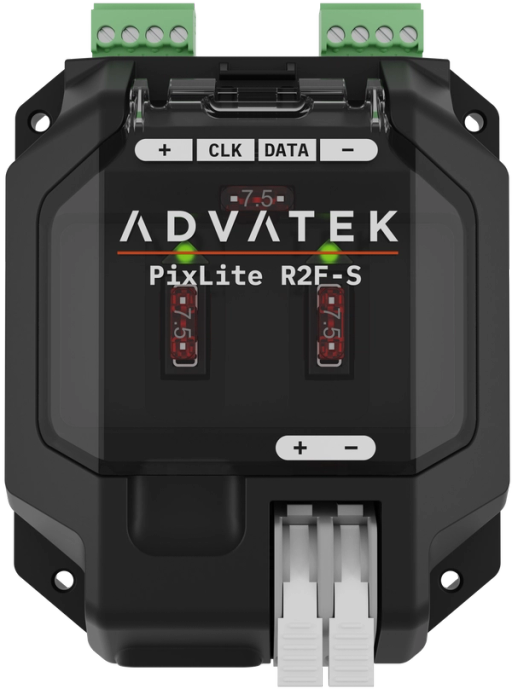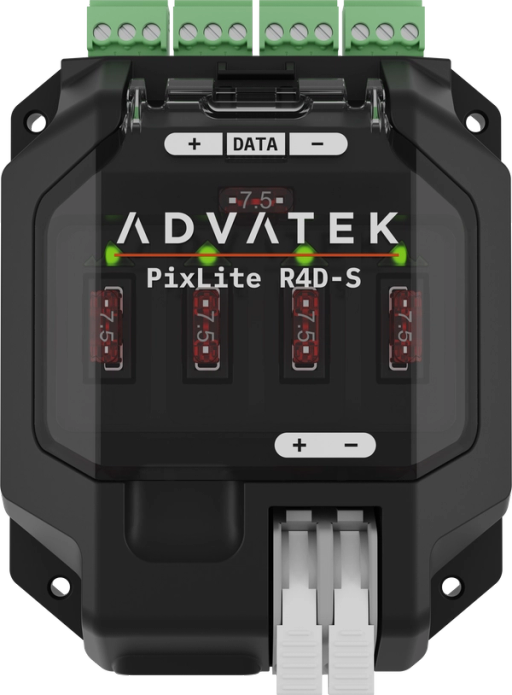
Overview of a Pixel Controller System
PixLite® Mk3 pixel controllers can come in many form factors, offering different feature sets and capabilities. This article provides an overview of the long-range system LED pixel control system, to help you know which controller is best for your installation.
A PixLite® Mk3 pixel controller takes incoming data from a source of lighting control, processes this data, and outputs pixel data through its outputs. This is the simplest implementation of a pixel controller and will generally be able to be used in most situations.

Regular pixel controller graphic
Distance Between the Controller and the Pixels
The cable that is used to connect a set of pixels to a pixel output is limited in length. PixLite® Mk3 pixel controllers can achieve a length of 15m between the pixel output and the first pixel. There are several factors that may affect this length, however. These include the following:
- Pixel Protocol – different pixel protocols run at different speeds. Data speed can affect data degradation, and so this can cause a limitation on distance. See the List of Supported Pixel Protocols to compare these speeds.
- Clock speed – When using clocked pixel types, selecting a slower clock speed can result in the potential for longer distances.
- Cable type – twisted pair cables and shielded core cables can provide better noise immunity, thus providing the potential for longer distances.
- External noise - electrical noise in close proximity (e.g. AC cables in a wall cavity) will affect the signal integrity, particularly when using unshielded cables.
Due to the variability of these factors across each installation, it is very difficult to theoretically know what distance will be appropriate in any given installation. The most accurate way to know is to physically connect test pixels using the same cable and pixels that are intended to be used in the final installation, or to use other external measurement equipment to evaluate signal integrity. As a rough guide, you can expect about 15m (49’) as a maximum distance before running into potential issues.
Note: This is a guide only and is subject to all previously mentioned variables. However, if there is doubt, then it may be safer to use the Long-Range system.
Long Range Solution
Installations may require pixels to be located far away from the main control device. In this situation, the long-range pixel control system is likely to be the best solution.
The PixLite® Long-Range system uses a far more robust electrical transmission method called "differential transmission". Long Range pixel controllers use this method to natively drive differential data between a transmitter and the receiver. The transmitter takes in incoming data from a source of lighting control and processes this data. It outputs differential data to the receiver units, which are then responsible for delivering pixel data through their pixel outputs.
The benefit of this system is that the connection between the transmitter and the receivers can be up to 300m in length – allowing pixels to be located at great distances from the main control device. This design is shown below.

PixLite® Long Range Pixel Controller graphic
The Long-Range system is very robust and is capable of transmitting data signals over at least 300 meters (1000’) even in noisy environments. It uses standard Cat5/6 network cables to do this, making it a very simple, cost effective and convenient way to control pixels over long distances.
PixLite receivers also feature full galvanic isolation, meaning the receiver will not require a common ground to be established with the transmitter. This also protects the rest of the system in the event of a failure of the receiver.
Summary
For installations where the distance between the main control device and the pixels is to be greater than 15m (49') from the controller, then the PixLite® Mk3 Long Range LED pixel control system is likely to be the best solution.

PixLite® T8-S Mk3
With a data transmission range of 300 meters, this user-friendly long range pixel controller system is the high-impact solution for professional installations.

PixLite® R2F-S
The R2F-S has two outputs, connecting to two runs of pixels and the long-range potential allows receivers to be located up to 300 meters away from the transmitter.

PixLite® R4D-S
Designed to bring sizable projects to life, the R4D-S receiver works together with the T8-S Mk3 transmitter to drive up to 2,040 RGB pixels for larger-scale installations.

